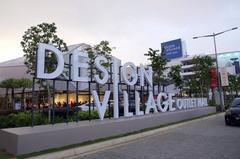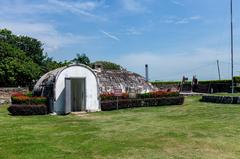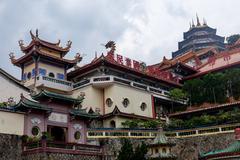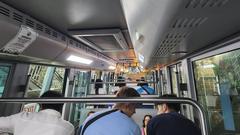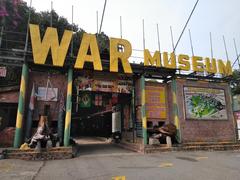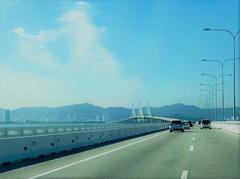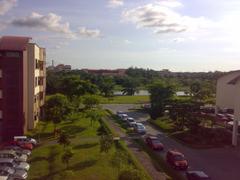Mahindarama Buddhist Temple Penang: Visiting Hours, Tickets, and Travel Guide
Date: 03/07/2025
Introduction
Mahindarama Buddhist Temple, nestled in the culturally vibrant city of Penang, Malaysia, is a distinguished landmark reflecting Sri Lankan Theravada Buddhist heritage and architectural artistry. Established in 1918, it stands as one of Malaysia’s earliest Sri Lankan Buddhist temples, renowned for its authentic architecture, spiritual significance, and enduring role in community and cultural preservation. Housing sacred Buddha relics and a Bodhi tree descended from the original enlightenment tree, the temple is a serene sanctuary for spiritual seekers, history enthusiasts, and cultural travelers alike. This guide offers detailed insights into Mahindarama’s history, architecture, religious practices, visiting hours, ticketing, accessibility, etiquette, special events, and travel tips, ensuring a respectful and meaningful visit. (Buddhistdoor, TBCM, BestThings.my)
Table of Contents
- Historical and Cultural Overview
- Early Buddhist Influences in Penang and Malaysia
- Development of Theravada Buddhism in Penang
- Founding and Expansion of Mahindarama Buddhist Temple
- Architectural Features and Artistic Elements
- Visiting Mahindarama: Hours, Tickets, and Accessibility
- Religious Significance and Practices
- Cultural and Community Roles
- Nearby Attractions and Travel Tips
- Visitor Etiquette and Guidelines
- Frequently Asked Questions (FAQ)
- Conclusion
- References
Historical and Cultural Overview
Mahindarama Buddhist Temple stands as a testament to Penang’s rich Buddhist heritage and multicultural spirit. Its legacy is deeply intertwined with the Sri Lankan Buddhist diaspora and the broader Buddhist landscape of Malaysia. The temple not only functions as a religious center but also as a hub for social welfare, education, and interfaith harmony.
Early Buddhist Influences in Penang and Malaysia
Buddhism arrived in the Malay Peninsula via ancient maritime trade routes, with archaeological finds at Lembah Bujang dating as early as the 5th century CE, and possibly to the 1st century CE, marking some of the oldest Buddhist sites in Southeast Asia (TBCM). Indian traders and the Srivijaya Kingdom played pivotal roles in spreading Buddhist practices, which later evolved alongside other religions in the region.
Development of Theravada Buddhism in Penang
Theravada Buddhism flourished in Penang with the arrival of communities from Sri Lanka, Thailand, and Burma in the 19th and 20th centuries. Notable temples such as the Dhammikarama Burmese Buddhist Temple (1803) and Wat Chaiyamangalaram (1845) laid the foundation for Penang’s diverse Buddhist landscape, catering to their respective communities and contributing to the island’s cosmopolitan character (TBCM).
Founding and Expansion of Mahindarama Buddhist Temple
Founded in 1918 by Venerable A. Pemaratana Maha Thera, Mahindarama is Malaysia’s earliest Sri Lankan Buddhist temple (Buddhistdoor). Named in honor of Arahat Mahinda, the temple reflects the Theravada lineage and serves as a focal point for Sri Lankan Buddhists and the wider Penang community. Over the years, it has expanded its offerings, including educational programs, medical clinics, and community services.
Architectural Features and Artistic Elements
Architectural Style and Layout
Mahindarama’s architecture is distinctly Sri Lankan, setting it apart from other local Buddhist temples. The complex centers around the Sīma (main prayer hall), with ancillary structures such as a library, school, bell tower, and multipurpose halls developed from the 1930s onwards. Open courtyards and lush gardens foster tranquility, while the Bodhi tree—descended from the original tree at Bodh Gaya—anchors the temple’s spiritual lineage (wikiwand.com).
Materials and Craftsmanship
Sri Lankan artisans crafted much of the temple’s interior using imported timber, gilded carvings, and vibrant murals. The Sīma hall is adorned with gold leaf, lacquer, and colored glass mosaics, creating a captivating atmosphere that embodies Theravada simplicity and reverence.
Key Iconography
- Main Shrine Hall: Features a large meditating Buddha statue surrounded by disciples and guardian deities, with murals illustrating the Jataka tales and the Buddha’s journey to enlightenment.
- Stupa and Relic Display: Houses sacred Buddha relics and the ashes of the founder, making Mahindarama a site of pilgrimage and veneration.
- Bell Tower: The multi-tiered bell tower, constructed in 1969, blends Sinhalese and Penang styles, and is used to mark significant religious events.
- Bodhi Tree: Planted from a sapling from Anuradhapura, Sri Lanka, this sacred tree is a living link to the Buddha’s enlightenment.
Visiting Mahindarama: Hours, Tickets, and Accessibility
Opening Hours
- The temple is generally open daily from 6:00 AM to 6:00 PM.
- The main prayer hall is accessible during these hours.
- Sundays and festival days are particularly lively, while weekdays offer a quieter experience (BestThings.my).
Admission and Donations
- Entry is free; no tickets required.
- Donations are welcome and help support the temple’s maintenance and charitable activities.
Accessibility
- Wheelchair accessible with ramps and paved paths.
- Assistance available upon request; some areas have steps or uneven surfaces.
- Parking is available nearby, though limited during festivals.
Guided Tours and Events
- Guided tours can be arranged in advance, offering deeper insights into the temple’s history and traditions.
- Special events such as Vesak Day and meditation retreats are open to all; check the official temple website or contact the temple office for updated schedules.
Religious Significance and Practices
Sacred Relics and Bodhi Tree
Mahindarama is unique for enshrining Buddha relics and housing a Bodhi tree directly traced to the original in Bodh Gaya. These features, along with the stupa and main hall, make the temple a revered pilgrimage and cultural site (wikiwand.com).
Vesak Day and Festivals
The temple is a focal point for Vesak Day celebrations, commemorating the Buddha’s birth, enlightenment, and passing. During this festival, the temple is adorned with lanterns and floral decorations, with processions, prayers, and merit-making activities. The Kathina celebration and other Buddhist festivals are also observed, encouraging community participation (Geocities.ws).
Meditation and Retreats
The Mahindarama Retreat Centre (Balik Pulau) and the Mahindarama Meditation Centre (Green Lane) offer meditation retreats and spiritual guidance. Programs are open to all, promoting mindfulness and compassion.
Cultural and Community Roles
Multicultural Integration
Originally established for Sri Lankan Buddhists, Mahindarama now welcomes devotees and visitors from all backgrounds, reflecting Penang’s multicultural ethos. Locally, it is affectionately referred to as “Gu-Leng Hood” or the Milk Buddha Temple, highlighting its integration into local culture.
Student Blessings and Traditions
Students regularly visit Mahindarama seeking blessings before exams, often offering milk as a symbolic gesture inspired by the Buddha’s enlightenment story. This tradition underscores the temple’s role in local customs.
Community Services and Education
- Free medical clinics, tuition classes, and scholarships are offered regardless of background.
- Buddhist Sunday schools educate hundreds of students in moral values and mindfulness.
- The temple also engages in humanitarian outreach, such as disaster relief efforts (Buddhistdoor).
Nearby Attractions and Travel Tips
Mahindarama’s central George Town location makes it an ideal starting point for exploring Penang’s cultural heritage. Notable nearby attractions include:
- Dhammikarama Burmese Buddhist Temple
- Wat Chaiyamangalaram
- Kek Lok Si Temple
- Pinang Peranakan Mansion
- Khoo Kongsi Clanhouse
- Penang Botanic Gardens
Local dining options and amenities are plentiful, with vegetarian restaurants and local eateries nearby (BestThings.my).
Visitor Etiquette and Guidelines
- Dress modestly: Shoulders and knees covered.
- Remove shoes: Before entering shrine halls.
- Maintain silence: Especially during prayers and meditation.
- Photography: Permitted outdoors; seek permission indoors or during ceremonies.
- Donations: Encouraged to support temple programs.
- Respect rituals: Observe or participate respectfully; ask staff for guidance.
Frequently Asked Questions (FAQ)
Q: What are Mahindarama Buddhist Temple’s visiting hours?
A: The temple is generally open daily from 6:00 AM to 6:00 PM.
Q: Is there an entrance fee?
A: No, entry is free. Donations are welcome.
Q: Are guided tours available?
A: Yes, tours can be arranged in advance.
Q: Is the temple accessible for people with disabilities?
A: Most areas are accessible; some uneven surfaces exist.
Q: Can visitors participate in activities?
A: Yes, especially on Sundays and during festivals.
Q: Is photography allowed?
A: Permitted outdoors; seek permission for indoor or ceremony photography.
Conclusion
Mahindarama Buddhist Temple is a beacon of Theravada Buddhism and Sri Lankan cultural heritage in Penang. Its sacred relics, Bodhi tree, and exquisite architecture offer a profound spiritual and cultural experience. The temple’s commitment to community service, education, and humanitarian outreach fosters intergenerational and intercultural harmony. Whether you’re seeking spiritual solace, cultural enrichment, or historical exploration, Mahindarama provides a welcoming sanctuary amid Penang’s bustling cityscape.
Plan your visit by checking the latest hours, observing temple etiquette, and exploring nearby historical landmarks for a holistic journey through Penang’s spiritual and cultural heart.
For updates and detailed visitor information, see the official temple website, or refer to local tourism resources.
References and Further Reading
- Mahindarama Buddhist Temple in Penang: History, Visitor Information & Cultural Significance (Buddhistdoor)
- Buddhism in Malaysia by K Don Premaseri (TBCM)
- Mahindarama Buddhist Temple Penang: Visiting Hours, Tickets & Architectural Highlights (wikiwand.com)
- Mahindarama Buddhist Temple Visiting Hours, Tickets & Guide (BestThings.my)
- Mahindarama Buddhist Temple Official Website (mahindaramatemple.org.my)
- Mahindarama Buddhist Temple Community Events (Geocities.ws)
